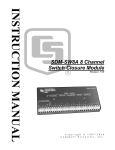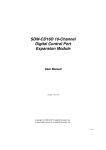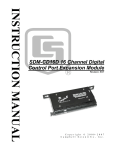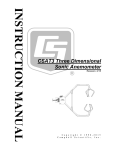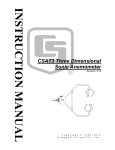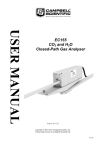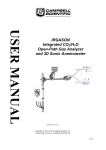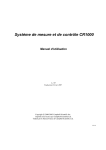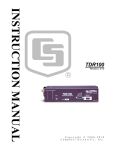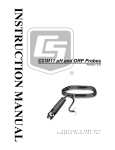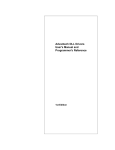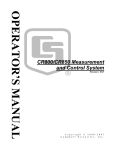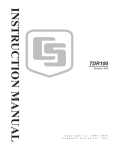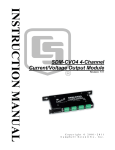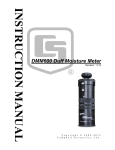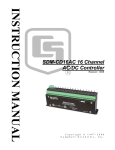Download Campbell Manufacturing SDM
Transcript
SDM-SW8A 8 Channel Switch Closure Module Revision: 7/07 C o p y r i g h t © 1 9 8 7 - 2 0 0 7 C a m p b e l l S c i e n t i f i c , I n c . Warranty and Assistance The SDM-SW8A SWITCH CLOSURE INPUT MODULE is warranted by CAMPBELL SCIENTIFIC, INC. to be free from defects in materials and workmanship under normal use and service for twelve (12) months from date of shipment unless specified otherwise. Batteries have no warranty. CAMPBELL SCIENTIFIC, INC.'s obligation under this warranty is limited to repairing or replacing (at CAMPBELL SCIENTIFIC, INC.'s option) defective products. The customer shall assume all costs of removing, reinstalling, and shipping defective products to CAMPBELL SCIENTIFIC, INC. CAMPBELL SCIENTIFIC, INC. will return such products by surface carrier prepaid. This warranty shall not apply to any CAMPBELL SCIENTIFIC, INC. products which have been subjected to modification, misuse, neglect, accidents of nature, or shipping damage. This warranty is in lieu of all other warranties, expressed or implied, including warranties of merchantability or fitness for a particular purpose. CAMPBELL SCIENTIFIC, INC. is not liable for special, indirect, incidental, or consequential damages. Products may not be returned without prior authorization. The following contact information is for US and International customers residing in countries served by Campbell Scientific, Inc. directly. Affiliate companies handle repairs for customers within their territories. Please visit www.campbellsci.com to determine which Campbell Scientific company serves your country. To obtain a Returned Materials Authorization (RMA), contact CAMPBELL SCIENTIFIC, INC., phone (435) 753-2342. After an applications engineer determines the nature of the problem, an RMA number will be issued. Please write this number clearly on the outside of the shipping container. CAMPBELL SCIENTIFIC's shipping address is: CAMPBELL SCIENTIFIC, INC. RMA#_____ 815 West 1800 North Logan, Utah 84321-1784 CAMPBELL SCIENTIFIC, INC. does not accept collect calls. SDM-SW8A Table of Contents PDF viewers note: These page numbers refer to the printed version of this document. Use the Adobe Acrobat® bookmarks tab for links to specific sections. 1. Function........................................................................1 2. Specifications ..............................................................2 3. Power Supply Considerations ....................................3 4. Connections .................................................................4 4.1 Connections to Dataloggers and Other SW8As........................................4 4.2 Sensor Connections ..................................................................................4 5. Internal Jumpers..........................................................4 5.1 Address Jumpers.......................................................................................4 5.2 Measurement Jumpers ..............................................................................6 6. Datalogger Programming............................................6 6.1 CRBasic Programming .............................................................................6 6.2 Edlog Programming..................................................................................7 7. Datalogger Program Details .......................................9 7.1 Datalogger Scan Rate ...............................................................................9 7.2 First Scan ..................................................................................................9 7.3 Watchdog Reset........................................................................................9 8. Measurement Applications .......................................10 8.1 8.2 8.3 8.4 SPDT Switch Closure .............................................................................10 SPST Switch Closure..............................................................................11 DC Voltage Pulse ...................................................................................11 Duty Cycle ..............................................................................................11 9. Theory of Operation ..................................................12 Appendix A. Program Example.................................................... A-1 i SDM-SW8A Table of Contents List of Tables 1. 2. 3. 4. 5. Datalogger to SDM-SW8A Connections................................................... 2 SDM-SW8A to SDM-SW8A Connections................................................ 3 Address Jumpers ........................................................................................ 5 Measurement Jumpers................................................................................ 6 Instruction 102 – SDM-SW8A .................................................................. 7 List of Figures 1. SDM-SW8A Front Panel ........................................................................... 1 2. SDM-SW8A Address and Port Configuration Jumpers with Sensor Wiring Examples......................................................................... 5 3. SPDT Signal Conditioning by SDM-SW8A............................................ 10 A-1. Example Program Flow Chart ........................................................... A-2 ii SDM-SW8A Switch Closure Input Module 1. Function The 8 channel SDM-SW8A Switch Closure Input Module (see Figure 1) measures up to 8 channels of switch closure or voltage pulse inputs. Each channel may be configured to read single-pole double-throw (SPDT) switch closure, single-pole single-throw (SPST) switch closure, or voltage pulse. Output options include counts, duty cycle, and state. The SW8A is addressed by the datalogger, allowing multiple SW8As to be connected to one datalogger (refer to Theory of Operation, Section 9). Sixteen addresses are available, but for most applications, Campbell Scientific, Inc. recommends no more than 4 SW8As be connected to one datalogger. If more SW8As are required, please consult Campbell Scientific's Marketing Department. In October, 1988, the SDM-SW8A was introduced. Edlog Instruction 102 is used for communication with the SW8A. CRBasic dataloggers use the SDMSW8A instruction. Previous to October, 1988, the SDM-SW8 (no "A") was offered for use only with the CR10, utilizing CR10 I/O Instruction 15. SDM-SW8As are not compatible with CR10s containing Instruction 15, and SDM-SW8s are not compatible with CR10s containing Instruction 102. Contact Campbell Scientific's Marketing Department for update options if incompatibilities exist. FIGURE 1. SDM-SW8A Front Panel 1 SDM-SW8A Switch Closure Input Module 2. Specifications Operating voltage: Current drain: Environmental: 12 VDC nominal (9.6 to 16) 3 mA quiescent, 6 mA active (max) -25 to +50oC, 0 to 90% RH, noncondensing Measurement types: Switch closure (SPDT, SPST) DC voltage pulse Input voltage threshold: From below 0.9 to above 4.0 VDC,±20 VDC max Maximum input frequency: 100 Hz (50% duty cycle) Minimum input pulse width: 5 ms high, 5 ms low Maximum bounce time: 3 ms open without counting Output options: State, duty cycle, counts Max count/port: 65535 Internal sampling frequency: 500 Hz Watchdog reset: Yes Total length of connecting cables: 20 feet Dimensions: 0.9"(H), 6.2"(L), 2.7"(W) Weight 0.5 lbs. (0.23 kg) Compatible dataloggers: CR10(X), CR800, CR850, CR1000, 21X, CR23X, CR3000, CR5000, and CR7 TABLE 1. Datalogger to SDM-SW8A Connections Datalogger 2 SDM-SW8A CR7 CR1000, CR800, CR850, CR23X, CR10(X) +12 (see Note 1) +12 12 V 12 V G G CR3000, CR5000 21X +12 C3 C3 C3 SDM-C3 C3 C2 C2 C2 SDM-C2 C2 C1 IN C1 C1 SDM-C1 C1 C1 OUT not used (see Note 2) not used (see Note 2) not used (see Note 2) 1H (see Note 2) SDM-SW8A Switch Closure Input Module TABLE 2. SDM-SW8A to SDM-SW8A Connections SDM-SW8A SDM-SW8A that’s connected to a CR10(X), CR800, CR850, CR1000, CR23X, CR3000, CR5000, or CR7 SDM-SW8A that’s connected to a 21X +12 12 V +12 C3 C3 C3 C2 C2 C2 C1 IN C1 IN C1 IN C1 OUT not used (see Note 2) C1 OUT (see Note 3) Notes: (1) If using an auxiliary power supply, instead of connecting the datalogger’s 12 V or +12 terminal to the SW8A, connect the power supply’s positive “+” wire to the SW8A’s +12 terminal. The power supply’s ground “-” wire terminal along with the wire that connects to the connects to the SW8A’s terminal. datalogger’s G or (2) When using a CR10(X), CR800, CR850, CR1000, CR23X, CR3000, or CR7, a jumper wire is used to connect the C1 IN to the C1 OUT. SDMSW8As shipped after March 1, 2006, include this jumper. (3) If you’re using a 21X and the SDM-SW8A was shipped after March 1, 2006, remove the jumper connecting C1 IN to C1 OUT. 3. Power Supply Considerations Due to the 3 mA continuous and 6 mA active current drain, an auxiliary 12 VDC power supply is recommended for powering the SW8A in remote, long term applications. For some applications it may be convenient to use the datalogger supply to power the SW8A. For long term applications where AC power is available, or where a solar panel can be used for recharging, the lead acid power supply available with Campbell Scientific, Inc. dataloggers could be used. For short term applications only, the alkaline power supply available with Campbell Scientific, Inc. dataloggers could be used to power the SW8A. If the 21X power supply is used to power the SW8A, all low level analog measurements (thermocouples, pyranometers, thermopiles, etc.) must be made differentially. This results from slight ground potentials created along the 21X analog terminal strip when the 12 V supply is used to power peripherals. This limitation reduces the number of available analog input channels and may mandate an external supply for the SW8A. 3 SDM-SW8A Switch Closure Input Module 4. Connections All connections to the datalogger, power supply, and other SW8As are made from terminals located under "TO DATALOGGER" on the SW8A (refer to Figure 1). Sensor connections are made at the remaining terminals. 4.1 Connections to Dataloggers and Other SW8As Connections between an SW8A and the CR10 and 21X dataloggers are shown in Table 1. Connections to multiple SW8As are shown in Table 2. CAUTION 1. The order in which connections are made is critical. ALWAYS CONNECT GROUND FIRST, followed by 12 V and then the Control Ports. 2. The sum of all the cable lengths connecting SW8As or other SDM devices and a datalogger should not exceed 20 feet. Lengths in excess of 20 feet may prevent communication. 4.2 Sensor Connections Figure 2 shows the connections between the SW8A and compatible sensor types. 5. Internal Jumpers Inside the SW8A, jumpers must be set to configure the Module address and the channel measurement type for each channel. Remove the two panel screws and lift the cover to access the jumpers. Figure 2 shows jumper location. 5.1 Address Jumpers Each module can have 1 of 16 addresses (00 to 33, Base 4). The address is factory set to 00. Figure 2 shows the location of the address jumper block. Table 3 lists the jumper settings for each address. 4 SDM-SW8A Switch Closure Input Module TABLE 3. Address Jumpers Pins Address 1-8 2-7 3-6 4-5 00 c c c c 01 c c c nc 02 c c nc c 03 c c nc nc 10 c nc c c 11 c nc c nc 12 c nc nc c 13 c nc nc nc 20 nc c c c 21 nc c c nc 22 nc c nc c 23 nc c nc nc 30 nc nc c c 31 nc nc c nc 32 nc nc nc c 33 nc nc nc nc c = connected nc = not connected FIGURE 2. SDM-SW8A Address and Port Configuration Jumpers with Sensor Wiring Examples 5 SDM-SW8A Switch Closure Input Module 5.2 Measurement Jumpers Near each input channel is a jumper triplet used to configure the channel for the measurement type. The SDM-SW8A is shipped from the factory with each channel configured for DC Voltage pulse. An example of each configuration is illustrated in Figure 2. Table 4 shows jumper pins and the corresponding measurement type. TABLE 4. Measurement Jumpers Measurement Type Pins Jumpered SPDT Switch Closure 1 and 6 SPST Switch Cl. or Open Coll. 2 and 5 Voltage Pulse 3 and 4 6. Datalogger Programming 6.1 CRBasic Programming The SW8A instruction is used to control the SDM-SW8A Eight-Channel Switch Closure module, and store the results of its measurements to a variable array. Parameter & Data Type Dest Variable or Array Reps Constant SDMAddress Constant 6 Enter The variable in which to store the results of the SW8A measurement. The variable array for this parameter must be dimensioned to the number of Reps. The number of channels that will be read on the SW8A. If (StartChan +Reps –1) is greater than 8, measurement will continue on the next sequential SW8A. In this instance, the addresses of the SDM devices must be consecutive. The address of the first SW8A with which to communicate. Valid SDM addresses are 0 through 15. If the SDMTrigger instruction is used in the program, address 15 should not be used. If the Reps parameter used more channels than are available on the first SW8A, the datalogger will increment the SDM address for each subsequent device that it communicates with. SDM-SW8A Switch Closure Input Module Parameter & Data Type FunctOp Constant StartChan Constant Mult, Offset Constant, Variable, Array, or Expression Enter The FunctOp is used to determine the result that will be returned by the SW8A. Numeric Function Code 0 Returns the state of the signal at the time the instruction is executed. A 0 is stored for low and a 1 is stored for high. 1 Returns the duty cycle of the signal. The result is the percentage of time the signal is high during the scan interval. 2 Returns a count of the number of positive transitions of the signal. 3 Returns a value indicating the condition of the module: ROM and RAM are good positive integer: RAM is bad negative value: ROM is bad Zero: The first channel that should be read on the SW8A. If the Reps parameter is greater than 1, measurements will be made on sequential channels. A multiplier and offset by which to scale the raw results of the measurement. See the measurement description for the units of the raw result; a multiplier of one and an offset of 0 are necessary to output in the raw units. For example, the TCDiff instruction measures a thermocouple and outputs temperature in degrees C. A multiplier of 1.8 and an offset of 32 will convert the temperature to degrees F. 6.2 Edlog Programming Instruction 102, Table 5, is used to address and retrieve information from the SW8A. TABLE 5. Instruction 102 - SDM-SW8A Parameter Number Data Type Description 01: 2 Repetitions 02: 2 Module Address (00..33) 03: 2 Function Option (0=State, 1=Duty 2=Counts, 3=Signature) 04: 2 SDM-SW8A Starting Channel (1..8) 05: 4 Starting input location for results 06: FP Mult 07: FP Offset 7 SDM-SW8A Switch Closure Input Module NOTE Instruction 102 is not contained in all CR10 or 21X PROMS. To verify that the datalogger contains the Instruction, enter 102 into a datalogger Programming Table. If the Instruction is accepted, the PROM contains the Instruction. Repetitions (Reps, Parameter 1) specifies the number of SW8A channels to read. Parameter 2 is the address of the first SW8A. If more Reps are requested than exist in one module, the datalogger automatically increments the address and continues to the next SW8A. The address settings for the SW8As must be sequential. For example, assume two SW8As with addresses of 22 and 23 are connected, and 12 Reps are requested. Eight channels from the first SW8A and the first four channels from the next will be read. Only one Function Option (Parameter 3) may be specified per Instruction. If all four functions are desired, four Instructions must be entered in the datalogger program. Function Option 0 provides the state of the signal at the time 102 is executed. A 1 or 0 corresponds to high or low states, respectively. Function Option 1 provides signal duty cycle. The result is the percentage of time the signal is high during the sample interval. Function Option 2 provides a count of the number of positive transitions of the signal. Function Option 3 provides the signature of the SW8A PROM. A positive number (signature) indicates the PROM and RAM are good, a zero (0) indicates bad PROM, and a negative number indicates bad RAM. Function Option 3 is not used but is helpful in "debugging." Only one Rep is required for Option 3. Parameter 4 specifies the first SW8A channel to be read (1..8). One or more sequential channels are read depending on the Reps. To optimize program efficiency, the sensors should be wired sequentially. Data are stored in sequential datalogger input locations, starting at the location specified in Parameter 5. The number of input locations consumed is equal to the number of Reps. The scaling multiplier and offset (Parameters 6 and 7) are applied to all readings. Enter 1 for the multiplier if no scaling is desired. If the SW8A does not respond, -99999 is loaded into input locations. Modules which do not respond when addressed by the datalogger are possibly wired or addressed incorrectly. Verify that the address specified in Parameter 2 corresponds to the jumper setting and that all connections are correct and secure. An example program for reading state, duty cycle, and counts of all 8 ports in a Module with an address of zero (0) is given in the Appendix. 8 SDM-SW8A Switch Closure Input Module 7. Datalogger Program Details 7.1 Datalogger Scan Rate The Module samples channel state every 2 ms and accumulates the information for duty cycle and counts. Each channel has one 16 bit accumulator for duty cycle and one for counts. The accumulators are reset when the datalogger requests information from the SW8A and when the count exceeds 65535. The datalogger scan rate must be frequent enough to avoid SW8A accumulator overflow. Each Duty Cycle accumulator resets every 131 seconds (2 ms * 65536) or roughly 2 minutes. If Duty Cycle is requested, the datalogger scan rate must be less than 131 seconds. The rate at which Count accumulators are reset is input frequency dependent. For example, at a maximum input frequency of 100 Hz, the datalogger must sample the SW8A at least every 655 seconds (approximately 10 minutes) or the accumulator for that channel resets and starts over again. 7.2 First Scan From the time power is applied, the SW8A samples the state of all channels every 2 ms. The first time the datalogger executes Instruction 102 and requests information, the results represent the time period since the SW8A was powered up, not the datalogger scan interval. This problem may be avoided by ignoring the data from the first scan after the datalogger is compiled. The example program (see Appendix) includes a routine which discards first scan data. 7.3 Watchdog Reset Any microprocessor may occasionally fail due to input transients or intermittent component failure (e.g., a bombed condition). The SW8A has a "watchdog" counter which resets the processor under such conditions. When functioning normally, the processor resets the watchdog counter. To transfer data between the datalogger and the SW8A, the datalogger drives the clock line, Control Port 2, high and low (refer to Theory of Operation, Section 9). The watchdog counts clock line transitions, and if the count exceeds 64, the watchdog resets the SW8A processor. Requesting State produces 16 clock transitions. Duty Cycle and Count each produce 24 + 16 clock transitions per channel. The length of time that the SW8A stays bombed before a watchdog reset occurs is a function of the datalogger scan rate and the amount of information requested from the Module. For example, if the datalogger scan rate is 10 minutes, and 2 channels of counts are requested, the SW8A may stay bombed for 20 minutes. To avoid this undesirable time delay before resetting, a trapping routine may be programmed into the datalogger to detect a bombed condition and immediately force a watchdog reset. The trapping routine keys on the fact that -99999 is stored in input locations when the Module is bombed (-99999 is also stored if the Module is incorrectly addressed or wired wrong). When -99999 is detected, the routine immediately 9 SDM-SW8A Switch Closure Input Module forces a watchdog reset by addressing the Module and requesting sufficient information to cause a minimum of 65 clock line transitions. Advantages to the trapping routine are: • The bombed processor is detected before erroneous values (-99999) are included in subsequent processing. • The processor may be reset sooner. • The time of processor failure may be logged by the datalogger. • Number of failures may be logged. A trapping routine, as described above, is included in the example program in the Appendix. 8. Measurement Applications 8.1 SPDT Switch Closure Single-pole double-throw switches may be found on some flow or volume sensors such as Watt-hour and water meters. The positive throw is connected to the 5 V terminal located next to the input channel, providing a 5 V bias for the SW8A to discriminate between throws. Similarly, the negative throw is connected to a ground terminal (refer to Figure 2, SPDT wiring example). When contact is made to the positive throw, SW8A circuitry holds a high state (5 V). When contact is made with the ground throw, a low state is maintained (0 V). Switch bounce may occur any number of times at a throw, but until contact is made with the opposite throw, a change in state will not occur. The pole must make contact with the throw for 3 ms for a state change to occur. Figure 3 illustrates a raw SPDT signal in relation to the signal conditioned by the SW8A. FIGURE 3. SPDT Signal Conditioning by SDM-SW8A NOTE 10 The 5V output located next to each of the 8 input channels is for biasing in the SPDT measurement. A 200 Ohm resistor is in series to protect against accidental shorting to ground. SDM-SW8A Switch Closure Input Module 8.2 SPST Switch Closure Single-pole single-throw switches are either open (high state) or connected to ground (low state). Typical SPST switches include contact closure (reed switch) anemometers, tipping bucket rain gauges, and open collectors (semiconductor switches). Many control devices utilize open collectors and provide terminals for monitoring the switch. For all SW8A measurements, the 100 Hz maximum input frequency and 5 ms pulse width specifications must be taken into consideration. To illustrate, consider the Met-One 014A Cup Anemometer which is an SPST-type sensor. The 014A calibration is: MPH = 1.789 * f + 1 where: MPH = miles per hour f = pulse frequency in Hz The 100 Hz maximum input frequency to the SW8A equates to 180 MPH. The duty cycle of the 014A as measured by the SW8A is 35%. A 5 ms pulse width becomes a limitation at 70 Hz (0.35/0.005sec), or about 126 MPH. The SW8A's maximum input frequency and 5 ms minimum pulse width specifications are not a limitation given the 014A's maximum calibrated speed of 100 MPH. 8.3 DC Voltage Pulse Voltage pulse transitions from below 0.9 V to above 4.0V, not exceeding ±20V, with a minimum pulse width of 5ms, are counted accurately at any frequency less than or equal to 100 Hz. 8.4 Duty Cycle Duty cycle is not an exact measurement due to the SW8A input filtering and 2 ms sampling frequency. Signal magnitude also affects duty cycle measurements. Optimum duty cycle measurements result if an integral number of cycles are measured per datalogger scan interval, and the scan interval is at least 1 second. Input Filtering and Sample Frequency Error - In a "worst case" analysis, input filtering will distort the time that the signal is high by ±2.5 ms. If the input filtering is at worst case, the 2 ms sampling frequency can create an error of ±2 duty cycle samples on any measurable cycle. Equations given below estimate the "worst case" duty cycle measurement error for a 50% duty cycle and the minimum/maximum measurable duty cycle for a given frequency. The error limits are calculated, assuming a sample interval of a single cycle. The error may be significantly reduced by allowing the SW8A to measure duty cycle over several cycles. As shown by the equations, the error decreases with decreasing frequency. 11 SDM-SW8A Switch Closure Input Module 50% Duty Cycle - The "worst case" duty cycle measurement error for a 50% duty cycle at a given input frequency is ±ERROR = Hz * 0.4 where ERROR = Actual Duty Cycle ±Measured Duty Cycle. For example, a 50% duty cycle at 10 Hz could be measured as 46% to 54% in the worst case. Minimum/Maximum - The measurable minimum/maximum duty cycle is defined by the 5 ms pulse width specification of the SW8A. For example, at a 10 Hz frequency, the minimum and maximum duty cycle that can be measured is 5% and 95%, respectively (0.005/0.100 * 100). The "worst case" duty cycle measurement error for the minimum/maximum measurable duty cycle is ±ERROR = Hz * 0.3 For example, the minimum measurable duty cycle for a 1 Hz signal is 0.5%. The duty cycle measurement could range from 0.2% to 0.8%. Signal Magnitude - The signal magnitude should range from 0 - 0.9 V low, to 4 - 5 V high, or the signal should be centered around 2.5 V with a minimum 8 V peak to peak magnitude. When the magnitude is 0 V to greater than 5 V, the wave form begins to distort, resulting in less accurate duty cycle information. 9. Theory of Operation The Switch Closure Input Module uses a 63705 microprocessor to sample the 8 ports and communicate with the datalogger. The processor is in a low power "Wait" mode except when interrupted. An internal timer interrupts the processor approximately every 2 milliseconds to sample the input ports. At this time, for each port, the duty cycle accumulator is updated, and the transition counter is incremented if the state represents a positive transition from the previous state. C3, driven high by the datalogger, also interrupts the SW8A. The SW8A prepares to receive an 8 bit byte (consisting of address in the most significant nibble and command in the least significant nibble with the least significant bit always a 1) from the datalogger. The datalogger drives C2 as a clock line and C1 as a serial data out line. The datalogger shifts out each bit (LSB first) on the falling edge of the clock; the Switch Closure Module shifts in each bit on the rising edge of the clock. When all 8 bits are received by the SW8A, the SW8A is again interrupted by its serial communication interface. If the address part of the byte received equals the jumpered address, the SW8A executes the command part, providing it is valid. For Function Options 1 and 2, the module receives another byte containing Reps and Channel information from the datalogger. For a valid address and command, the SW8A prepares to return a code byte as acknowledgment to the datalogger. Except for the 21X, the datalogger switches C1 to an input and after 2 milliseconds clocks back the code byte from the SW8A. If the code byte is correct, the datalogger knows the 12 SDM-SW8A Switch Closure Input Module addressed SW8A is present. The 21X works similarly, except the data from the SW8A is input to single ended analog channel 1, not C1. Depending on the Command, Reps, and Channel information, the module will shift out one or more bytes to the datalogger, again using C2 as a clock driven by the datalogger. The module shifts out each bit on the falling edge of the clock; the datalogger reads each bit on the rising edge of the clock. Each time an entire byte is transmitted to the datalogger, the SW8A is interrupted and prepares to send the next byte, if any. When all requested bytes have been sent, the SW8A disables its serial communication interface and waits for both C3 and C2 to be driven low by the datalogger. When this happens, the SW8A prepares again to start a new command cycle. An important feature of the module is its watchdog counter. The counter pulls the processor momentarily into reset if the count gets too high. The counter counts the C2 clock transitions. Under normal operating conditions, the processor resets the counter. If the processor is "bombed," it will not reset the counter. As the datalogger makes requests of the Switch Closure Module, the counter increments to the point where it resets the processor; the module will then start operating correctly again. 13 SDM-SW8A Switch Closure Input Module This is a blank page. 14 Appendix A. Program Example The Edlog program is an example only and is not meant to be used verbatim. In application, the concepts illustrated here are likely to be only fragments of a larger program. The example program reads all 8 ports of an SW8A which is set to address 00. It is read three times per scan, once each for State, Duty Cycle, and Count information. The scan rate is fixed at 1 second, with a 5 minute output of State, average Duty Cycle, and average Count. To prevent erroneous values from being included in Output Processing routines, the datalogger's Intermediate Processing Disable Flag (Flag 9) is set under the following two conditions. 1. When the SW8A is not responding - If the processor is not responding, a value of -99999 is detected in the first Location containing SW8A data, and Flag 9 is set high. The SW8A is accessed a second time to increment the watchdog counter to greater than 64 and force a watchdog reset (refer to Section 7.3). A RESET COUNTER (input location 25, RESET CNT) is incremented and output with time to create a record of when and how many times the SW8A has been reset since the last datalogger compilation. 2. When the current scan is the first scan after compiling the datalogger program - If the datalogger program is compiled in the *0 Mode, all Flags are set low following compilation. To detect the first scan after the datalogger is compiled, the state of user Flag 1 is checked. If Flag 1 is low the Intermediate Disable Flag (Flag 9) is set high to prevent the first readings from being included in subsequent Output Processing Instructions. Flag 1 is set high at the end of the first scan. A flow chart of the example program is presented in Figure A-1. A-1 Appendix A. Program Example FIGURE A-1. Example Program Flow Chart PROGRAM EXAMPLE Input Locations Used: 1:STATE #1 13:DUTY #5 2:STATE #2 14:DUTY #6 3:STATE #3 15:DUTY #7 4:STATE #4 16:DUTY #8 5:STATE #5 17:COUNT#1 6:STATE #6 18:COUNT #2 7:STATE #7 19:COUNT #3 8:STATE #8 20:COUNT #4 9:DUTY #1 21:COUNT #5 10:DUTY #2 22:COUNT #6 11:DUTY #3 23:COUNT #7 12:DUTY #4 24:COUNT #8 25:RESET CNT Output Arrays: ID = 105, 27 ELEMENTS ID = 112, 4 ELEMENTS 105, DAY, HRMN, STATE #1,... STATE #8, DUTY #1, ... DUTY #8, COUNT #1, ... COUNT #8 112, DAY, HRMN, RESET COUNT A-2 Appendix A. Program Example *Table 1 Programs 01: 1 Sec. execution interval 1: Do (P86) 1: 1 Call Subroutine 1 If SDM-SW8A was just programmed or its processor is bombed, set intermediate processing disable flag. 2: 1 If Flag/Port (P9) 1: 21 Do if flag 1 is low 2: 19 Set high Flag 9 3: If X<=>F (P89) 1: 1 2: 4 3: 0 4: 19 X Loc state #1 < F Set high Flag 9 OUTPUT STATE AND AVERAGE DUTY CYCLE EVERY 5 MINUTES. 4: If time is (P92) 1: 0 minutes into a 2: 5 minute interval 3: 10 Set high Flag 0 (output) 5: Real Time (P77) 1: 110 Day,Hour-Minute 6: Sample (P70) 1: 8 2: 1 Reps Loc state #1 7: Average (P71) 1: 16 Reps 2: 9 Loc duty #1 ******* START TRAPPING ROUTINES ******* 8: If Flag/Port (P91) 1: 19 Do if flag 9 is high 2: 30 Then Do 9: If Flag/Port (P91) 1: 11 Do if flag 1 is high 2: 30 Then Do ************* RESET ROUTINE ************* To force a watchdog reset, increment reset counter, output time and number of resets, and set flag 1 low. A-3 Appendix A. Program Example 10: Do (P86) 1: 1 Call Subroutine 1 11: Z=Z+1 (P32) 1: 25 Z Loc [:RESET CNT] 12: Do (P86) 1: 10 Set high Flag 0 (output) 13: Real Time (P77) 1: 110 Day,Hour-Minute 14: Sample (P70) 1: 1 Reps 2: 25 Loc RESET CNT 15: Do (P86) 1: 21 Set low Flag 1 ********** FIRST SCAN ROUTINE ********** 16: Else (P94) 17: Do (P86) 1: 11 Set high Flag 1 18: End (P95) 19: End (P95) 20: End Table 1 *Table 3 Subroutines ** SUBROUTINE TO MEASURE SDM-SW8A ** 1: Beginning of Subroutine (P85) 1: 1 Subroutine Number 2: SDM-SW8A (P102) 1: 8 Reps 2: 00 Address 3: 0 Channel state(s) function 4: 1 Chan 5: 1 Loc [:state #1 ] 6: 1 Mult 7: 0 Offset A-4 Appendix A. Program Example 3: SDM-SW8A (P102) 1: 8 Reps 2: 00 Address 3: 1 Duty cycle function 4: 1 Chan 5: 9 Loc [:duty #1 ] 6: 1 Mult 7: 0 Offset 4: SDM-SW8A (P102) 1: 8 Reps 2: 00 Address 3: 2 Counts function 4: 1 Chan 5: 17 Loc [:counts #1] 6: 1 Mult 7: 0 Offset 5: End (P95) 6: End Table 3 A-5 Appendix A. Program Example This is a blank page. A-6 This is a blank page. Campbell Scientific Companies Campbell Scientific, Inc. (CSI) 815 West 1800 North Logan, Utah 84321 UNITED STATES www.campbellsci.com [email protected] Campbell Scientific Africa Pty. Ltd. (CSAf) PO Box 2450 Somerset West 7129 SOUTH AFRICA www.csafrica.co.za [email protected] Campbell Scientific Australia Pty. Ltd. (CSA) PO Box 444 Thuringowa Central QLD 4812 AUSTRALIA www.campbellsci.com.au [email protected] Campbell Scientific do Brazil Ltda. (CSB) Rua Luisa Crapsi Orsi, 15 Butantã CEP: 005543-000 São Paulo SP BRAZIL www.campbellsci.com.br [email protected] Campbell Scientific Canada Corp. (CSC) 11564 - 149th Street NW Edmonton, Alberta T5M 1W7 CANADA www.campbellsci.ca [email protected] Campbell Scientific Ltd. (CSL) Campbell Park 80 Hathern Road Shepshed, Loughborough LE12 9GX UNITED KINGDOM www.campbellsci.co.uk [email protected] Campbell Scientific Ltd. (France) Miniparc du Verger - Bat. H 1, rue de Terre Neuve - Les Ulis 91967 COURTABOEUF CEDEX FRANCE www.campbellsci.fr [email protected] Campbell Scientific Spain, S. L. Psg. Font 14, local 8 08013 Barcelona SPAIN www.campbellsci.es [email protected] Please visit www.campbellsci.com to obtain contact information for your local US or International representative.


























